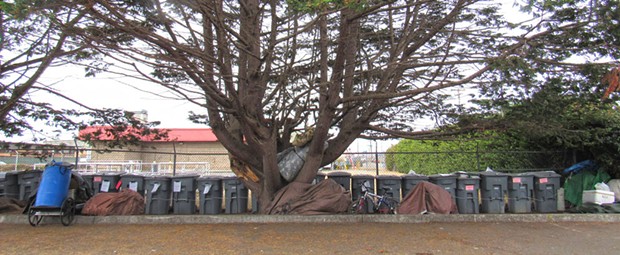Putting Heads Together for Housing First
Humboldt County has one of the highest rates of chronically homeless people in the United States
By Linda Stansberry [email protected] @lcstansberry[
{
"name": "Top Stories Video Pair",
"insertPoint": "7",
"component": "17087298",
"parentWrapperClass": "fdn-ads-inline-content-block",
"requiredCountToDisplay": "1"
}
]
It's Thursday, Aug. 11, moving day, and the Eureka Police Department is busy. Every morning at around 6:30, several officers visit the parking lot where homeless people are allowed to sleep between 7 p.m. and 7 a.m. The "designated temporary overnight sleeping areas," as city employees call them — the word "camps" is strictly verboten — are the current workaround to the sticky issue of what to do with the nebulous population of people sleeping rough in Eureka. Around 100 were displaced on May 2 when — after more than a year of debate — the city officially disbanded the unsanctioned camp that had spread behind the Bayshore Mall in the PalCo Marsh. Around 30 former marsh campers found sanctuary in a village of converted shipping containers run by the Betty Chinn Foundation, some disappeared into greenbelts or left town, and some return nightly to the parking lot at Washington and Koster streets, one of the three locations the city has designated as "low enforcement zones," meaning people can sleep there without being rousted and ticketed by the police. At least, that is, until morning comes.
"We do roughly 10 patrol checks every day, at least in addition to when officers go down on their own, " says EPD Capt. Steve Watson. "Plus staff has multiple officers get there between 6:30 and 7. It's been a struggle, quite frankly, to get them up and moving."
Aug. 11 was a day of added challenges for the officers and the roughly 30 people sleeping at the Wharfinger Building parking lot, as the 14-day period in which people were allowed to sleep there had ended and they had to be reminded to move to Koster and Washington streets. The spot has been rotated every two weeks for the last two months, with belongings stored in plastic garbage cans and moved by city staff from one area to another.
The sleeping area solution, admits Watson, is not a perfect one.
"I would say, at the end of the day, I still see where we're at now as an improvement over the marsh. There were a vast amount of resources [used] there. It is an improvement, the best we can do. I don't know many other places in the country that are doing what we're doing. Where we are today is much better than May 2."
Meanwhile, a mile away, more than 300 people have gathered at the Adorni Center, seeking a better solution. It's the pinnacle of the city of Eureka and county of Humboldt's Housing Summit, which kicked off earlier in the week with a pledge to house 30 people in 60 days. The keynote speaker is Sam Tsemberis, a clinical and community psychology practitioner from Canada often credited with founding the Housing First movement. Robert Ward, administrative analyst with the Humboldt County Department of Health and Human Services, kicks off the event with a grim statistic: According to the 2015 Point in Time counts, the number of chronically homeless people in Humboldt County, per capita, is higher than Washington, D.C.
Actually, according to statistics compiled by DHHS, Humboldt County has proportionately more chronically homeless people than many major metropolitan areas in the country, including San Francisco, Boston and even New York City. Chronically homeless, as defined by the Department of Housing and Urban Development, is "an individual with a disabling condition ... who has either been continuously homeless for a year or more or has had at least four episodes of homelessness in the past three years." Disabling conditions can include mental health and substance abuse disorders. People who meet these criteria are being prioritized by DHHS and the Eureka for its Housing First initiative. But what Housing First means requires definition as well, says Sally Hewitt, senior program manager at DHHS.
"We kept hearing different versions about what it is from different sectors of the community," says Hewitt in a phone interview. "Some were saying Housing First means build housing first, other groups say that tents are housing first, or that tiny houses are housing first. We're not saying that these ideas don't have value, but we want everyone to be on the same page."
In his speech, Tsemberis praises the "commendable" work already accomplished by the county. He revisits the foundational principle of Housing First: Rather than demand people be "housing ready" by addressing mental health or substance abuse issues, put people in housing, then give them the skills and support they need to stay there. Although it's a relatively young movement, studies have shown significant reductions in chronic homelessness and costs to government with the Housing First approach.
"I know you can do this," Tsemberis says. "You're most of the way there already."
About an hour into his speech, Betty Chinn slips quietly from the room. She has work to do, preparing lunch for the hungry, as she has done every day for more than 30 years. Before lunch, she confers with James Rockwell in the middle of the Mercer-Fraser parking lot at Third and Commercial streets, where around 30 people are living in converted shipping containers. Rockwell is project manager for the Greater Eureka Community Outreach Program, also dubbed the Blue Angel Village. In the last three months, 26 of the 66 people staying at the village went on to find housing and 27 others found employment.
"This is a training ground for people," Chinn says. "We show them how to live inside."
"The best thing about it is how low the barrier is to stay here," says Rockwell. People staying at the village do not have to be clean or sober, and they can bring their dogs. Chinn often plucks them directly off the streets or from the designated sleeping areas. She says the sleeping areas are rowdy at night, a difficult place to rest. One man, she says, was so fatigued that when he came in he slept for 20 hours straight. Once they've slept and showered, once they feel safe, they are able to access services from the Mobile Intervention Services Team and other entities. It's been a successful project, according to Chinn, although it's temporary, due to end in three months. And although the village and other shelters such as the Multiple Assistance Center represent a temporary respite from the stresses of the street, they do not meet the definition of permanent, supportive housing as recommended by the Housing First movement.
Outside on Third Street, there's a steady stream of people walking past or just sitting on the sidewalk with dogs and backpacks. This, Chinn says, is where many go between 7 a.m. and 7 p.m. These are the people social workers, case managers and housing specialists will be trying to reach and place in what, by all measurements, is a finite resource: housing.
Back at the summit, the crowd has broken into groups to brainstorm how to recruit landlords. Don Smullin, executive director of the Eureka Chamber of Commerce, is going around with a clipboard, looking for landlords to sign up for a presentation the chamber is hosting.
"The pool of people we want to get into the apartments, they have lots of challenges," admits Hewitt.
To incentivize landlords to accept clients, DHHS created a mitigation fund to pay for any damage (Hewitt says several employees chipped in) and is emphasizing the supportive services offered by the county, including a hotline for landlords. The historically low turnover rate for clients with support services, Hewitt and others say, should be a point in their favor. Still, systemic challenges remain.
In a breakout group to discuss landlord recruitment, several case managers with the Redwood Community Action Agency, the MAC and the city of Eureka discuss their biggest hurdles. The biggest property management companies are spoiled for choice, they say, with a very low vacancy rate (around 3 percent as determined by consultancy group Focus Strategies) and lots of applicants. If applicants have an eviction on their records, they're automatically rejected. Case managers can help a client write a cover letter explaining their circumstances, but those are rarely read.
As they and others search for solutions, the clock is ticking. The city and county have pledged to house 30 people in 60 days, with a deadline of Oct. 7. The effort includes aggressive work by MIST, DHHS caseworkers, and referrals from 211, a community switchboard. As of press time, they had placed one client, with 29 more to go.
Comments (5)
Showing 1-5 of 5
more from the author
-
Lobster Girl Finds the Beat
- Nov 9, 2023
-
Tales from the CryptTok
- Oct 26, 2023
- More »
Latest in News
Readers also liked…
-
Through Mark Larson's Lens
A local photographer's favorite images of 2022 in Humboldt
- Jan 5, 2023
-
'To Celebrate Our Sovereignty'
Yurok Tribe to host gathering honoring 'ultimate river warrior' on the anniversary of the U.S. Supreme Court ruling that changed everything
- Jun 8, 2023


































